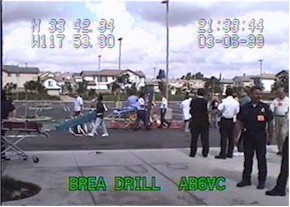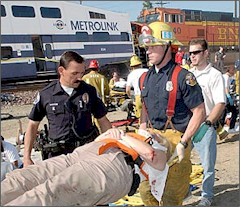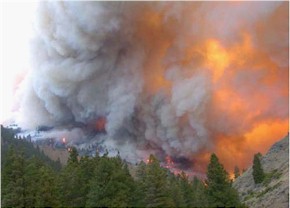|
Visual Communications
The
familiar statement, "A picture is worth a thousand words," describes
how pictures can save someone from verbally communicating an important message.
Fast-scan
amateur television
(ATV) and slow-scan television (SSTV) have proven themselves in Orange
County by providing multipoint-distribution of "live" and
"static" picture documentation of important public-safety drills
and emergency events such as floods and fires that can be transmitted to an
EOC or command post. ATV and SSTV
support public safety by providing a
window into an event, thereby providing a decision-making tool based upon
pictures viewed.
Fast
scan is real-time television that uses UHF or higher amateur radio
frequencies. It’s similar to home TV, complete with color and sound.
Slow-scan television (SSTV) is another popular mode used primarily to send
narrowband, high-resolution, color, still photos taken from live events or
recorded video.
ATV
and SSTV stations may be operated from radio amateurs' homes, cars
and trucks, boats, airplanes and helicopters, or backpacks carried by the
communicators.
Some
County of Orange RACES personnel have amateur television equipment that's either fast-scan or slow-scan
or both. A typical fast-scan ATV system consists of a low-light-level portable color
television camera (with character generator for call sign and GPS data), a 10-watt PEP
or more UHF ATV transmitter, a crystal-controlled UHF receiving
downconverter, a TV monitor, a VCR (video cassette recorder), and UHF
antennas. This equipment is capable of portable operation, using a 12-Vdc
power source or rechargeable batteries. A
slow-scan system may consist of a Kenwood VC-H1 Visual Communicator, a VHF/UHF transceiver, and batteries to power the equipment.
Slow-scan software is also used on PCs to receive and send SSTV
pictures, using a VHF/UHF transceiver.
SSTV images are narrowband and may also be sent via HF radio.
The
pictures below illustrate how fast and slow scan can be used to bring an
event window into your EOC or command post.

Fast-scan image sent from Brea Drill.
 
Slow-scan images sent from Placentia train crash (left)
and from wildfire (right).
|